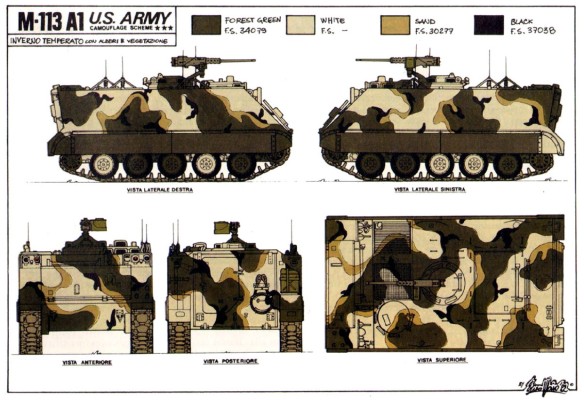
The M113A1, informally known as the Gavin, is a lightly armoured full tracked air transportable personnel carrier designed to carry personnel and certain types of cargo. The M113-family was developed from M59 and M75 by Ford and Kaiser Aluminium and Chemical Co. in the late 1950s. The vehicle is capable of amphibious operations in streams and lakes; extended cross country travel over rough terrain; and high speed operation on improved roads and highways.
M113 series full tracked APC was developed in late 1950s and first vehicles completed in 1960, powered by petrol engine. M113 was replaced in production by diesel-powered M113A1 in 1964 which in turn was replaced by M113A2 with a number of automotive improvements. Latest model is M113A3 which entered service in 1987 and has many improvements including more powerful engine, spall liners and optional applique armour. By 1999 over 76,000 M1l3s and its variants had been built, including about 4,500 built in Italy by OTOBREDA. Basic vehicle is fully amphibious, propelled in the water by its tracks. Before entering the water a trim vane is erected at front of hull and bilge pumps switched on.
Since their initial introduction in 1960, M113-based systems have entered service in more than 50 countries. The systems have been modified into more than 40 identified specific variants, with many times that number of minor field modifications. Many of these modifications have been developed by foreign governments to meet their specific national requirements. While some older M113 derivatives are being retired and removed from selected inventories, other FOV members are being upgraded, reconfigured, and introduced as entirely new systems.
More than 80,000 M113 Family of Vehicle (FOV) systems have been produced. New M113 FOV systems are being built while existing chassis are being upgraded to modern configurations.
The M113 APC was the first modern “battle taxi”; developed to transport infantry forces on the mechanized battlefield. It is fitted with a 2 stroke six cylinder Detroit diesel providing power through a 3 speed automatic gearbox and steering differential. The main armament is a single .50 Cal heavy barrel machine gun, and the secondary armament is a single .30 Cal machine gun. The M113 is built of aircraft quality aluminum which allows it to possess some of the same strengths as steel at a much lighter weight. This distinct weight advantage allows the M113 to utilize a relatively small engine to power the vehicle, as well as carry a large payload cross-country. The vehicle is capable of “swimming” bodies of water.
The vehicle is not mission capable if any one track shoe is damaged. If the M113 loses a track, breaks a track shoe or the vehicle throws a track, extreme caution must be exercised in maintaining control. The driver must immediately release the accelerator and let the vehicle coast to a stop. Applying braking action, i.e. brake pedal, laterals, pivot or any type of steering controls causes the vehicle to pull to the active or good track and could result in a roll-over. If it is absolutely necessary, the driver may apply braking action only, and only if the vehicle is approaching a ravine, a cliff, or if other catastrophic outcome, probably resulting in fatalities. When roll-over is imminent; it is safer to stay in the vehicle than to try to get out while the vehicle is still moving. Crew members may receive slight injuries from being thrown against metal parts, but if they try to leave the vehicle, it may roll over and crush them. Once the vehicle stops moving, the crew should get out as fast as possible because spilled fuel and oil may catch on fire. The first thing the driver should do in such an emergency is shut off the engine and turn off the master switch to minimize the fire hazard.
M113 Armored Personnel Carrier
The original M113 Armored Personnel Carrier (APC) helped to revolutionize mobile military operations. The vehicles were able to carry 11 soldiers plus a driver and track commander under armor protection across hostile battlefield environments. More importantly, the new vehicles were air transportable, air-droppable, and swimmable, allowing planners to incorporate APCs in a much wider range of combat situations, including many “rapid deployment” scenarios. The M113s were so successful that they were quickly identified as the foundation for a family of vehicles. Early derivatives included both command post (M577) and mortar carrier (M106) configurations.
M113A1 Armored Personnel Carrier
The first major upgrade came in 1964 with the introduction of the M113A1 package which replaced the original gasoline engine with a 212 horsepower diesel package. The new power train was soon incorporated into the existing vehicle family as the M113A1, M577A1, and M106A1, as well as several new derivative systems. Some of these new derivatives were based on the armored M113 chassis (the M125A1 mortar carrier and M741 “Vulcan” air defense vehicle) while others were based on an unarmored version of the chassis (including the M548 cargo carrier, M667 “Lance” missile carrier, and M730 “Chaparral” missile carrier).